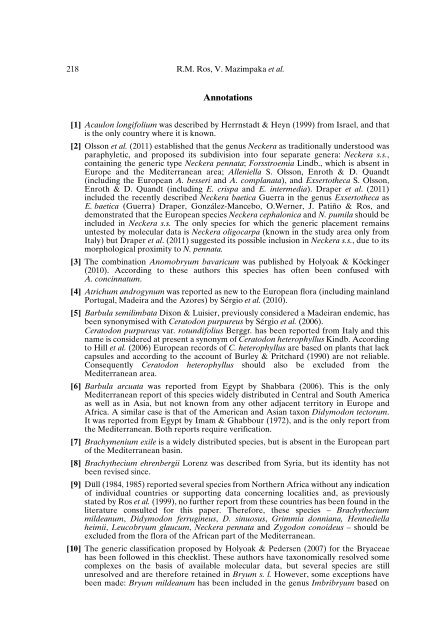Mosses of the Mediterranean, an annotated checklist - Optima-bot.org
Mosses of the Mediterranean, an annotated checklist - Optima-bot.org
Mosses of the Mediterranean, an annotated checklist - Optima-bot.org
Create successful ePaper yourself
Turn your PDF publications into a flip-book with our unique Google optimized e-Paper software.
218 R.M. Ros, V. Mazimpaka et al.Annotations[1] Acaulon longifolium was described by Herrnstadt & Heyn (1999) from Israel, <strong>an</strong>d thatis <strong>the</strong> only country where it is known.[2] Olsson et al. (2011) established that <strong>the</strong> genus Neckera as traditionally understood wasparaphyletic, <strong>an</strong>d proposed its subdivision into four separate genera: Neckera s.s.,containing <strong>the</strong> generic type Neckera pennata; Forsstroemia Lindb., which is absent inEurope <strong>an</strong>d <strong>the</strong> <strong>Mediterr<strong>an</strong>e<strong>an</strong></strong> area; Alleniella S. Olsson, Enroth & D. Qu<strong>an</strong>dt(including <strong>the</strong> Europe<strong>an</strong> A. besseri <strong>an</strong>d A. compl<strong>an</strong>ata), <strong>an</strong>d Exserto<strong>the</strong>ca S. Olsson,Enroth & D. Qu<strong>an</strong>dt (including E. crispa <strong>an</strong>d E. intermedia). Draper et al. (2011)included <strong>the</strong> recently described Neckera baetica Guerra in <strong>the</strong> genus Exserto<strong>the</strong>ca asE. baetica (Guerra) Draper, González-M<strong>an</strong>cebo, O.Werner, J. Patiño & Ros, <strong>an</strong>ddemonstrated that <strong>the</strong> Europe<strong>an</strong> species Neckera cephalonica <strong>an</strong>d N. pumila should beincluded in Neckera s.s. The only species for which <strong>the</strong> generic placement remainsuntested by molecular data is Neckera oligocarpa (known in <strong>the</strong> study area only fromItaly) but Draper et al. (2011) suggested its possible inclusion in Neckera s.s., due to itsmorphological proximity to N. pennata.[3] The combination Anomobryum bavaricum was published by Holyoak & Köckinger(2010). According to <strong>the</strong>se authors this species has <strong>of</strong>ten been confused withA. concinnatum.[4] Atrichum <strong>an</strong>drogynum was reported as new to <strong>the</strong> Europe<strong>an</strong> flora (including mainl<strong>an</strong>dPortugal, Madeira <strong>an</strong>d <strong>the</strong> Azores) by Sérgio et al. (2010).[5] Barbula semilimbata Dixon & Luisier, previously considered a Madeir<strong>an</strong> endemic, hasbeen synonymised with Ceratodon purpureus by Sérgio et al. (2006).Ceratodon purpureus var. rotundifolius Berggr. has been reported from Italy <strong>an</strong>d thisname is considered at present a synonym <strong>of</strong> Ceratodon heterophyllus Kindb. Accordingto Hill et al. (2006) Europe<strong>an</strong> records <strong>of</strong> C. heterophyllus are based on pl<strong>an</strong>ts that lackcapsules <strong>an</strong>d according to <strong>the</strong> account <strong>of</strong> Burley & Pritchard (1990) are not reliable.Consequently Ceratodon heterophyllus should also be excluded from <strong>the</strong><strong>Mediterr<strong>an</strong>e<strong>an</strong></strong> area.[6] Barbula arcuata was reported from Egypt by Shabbara (2006). This is <strong>the</strong> only<strong>Mediterr<strong>an</strong>e<strong>an</strong></strong> report <strong>of</strong> this species widely distributed in Central <strong>an</strong>d South Americaas well as in Asia, but not known from <strong>an</strong>y o<strong>the</strong>r adjacent territory in Europe <strong>an</strong>dAfrica. A similar case is that <strong>of</strong> <strong>the</strong> Americ<strong>an</strong> <strong>an</strong>d Asi<strong>an</strong> taxon Didymodon tectorum.It was reported from Egypt by Imam & Ghabbour (1972), <strong>an</strong>d is <strong>the</strong> only report from<strong>the</strong> <strong>Mediterr<strong>an</strong>e<strong>an</strong></strong>. Both reports require verification.[7] Brachymenium exile is a widely distributed species, but is absent in <strong>the</strong> Europe<strong>an</strong> part<strong>of</strong> <strong>the</strong> <strong>Mediterr<strong>an</strong>e<strong>an</strong></strong> basin.[8] Brachy<strong>the</strong>cium ehrenbergii Lorenz was described from Syria, but its identity has notbeen revised since.[9] Düll (1984, 1985) reported several species from Nor<strong>the</strong>rn Africa without <strong>an</strong>y indication<strong>of</strong> individual countries or supporting data concerning localities <strong>an</strong>d, as previouslystated by Ros et al. (1999), no fur<strong>the</strong>r report from <strong>the</strong>se countries has been found in <strong>the</strong>literature consulted for this paper. Therefore, <strong>the</strong>se species – Brachy<strong>the</strong>ciummilde<strong>an</strong>um, Didymodon ferrugineus, D. sinuosus, Grimmia donni<strong>an</strong>a, Hennediellaheimii, Leucobryum glaucum, Neckera pennata <strong>an</strong>d Zygodon conoideus – should beexcluded from <strong>the</strong> flora <strong>of</strong> <strong>the</strong> Afric<strong>an</strong> part <strong>of</strong> <strong>the</strong> <strong>Mediterr<strong>an</strong>e<strong>an</strong></strong>.[10] The generic classification proposed by Holyoak & Pedersen (2007) for <strong>the</strong> Bryaceaehas been followed in this <strong>checklist</strong>. These authors have taxonomically resolved somecomplexes on <strong>the</strong> basis <strong>of</strong> available molecular data, but several species are stillunresolved <strong>an</strong>d are <strong>the</strong>refore retained in Bryum s. l. However, some exceptions havebeen made: Bryum milde<strong>an</strong>um has been included in <strong>the</strong> genus Imbribryum based on






